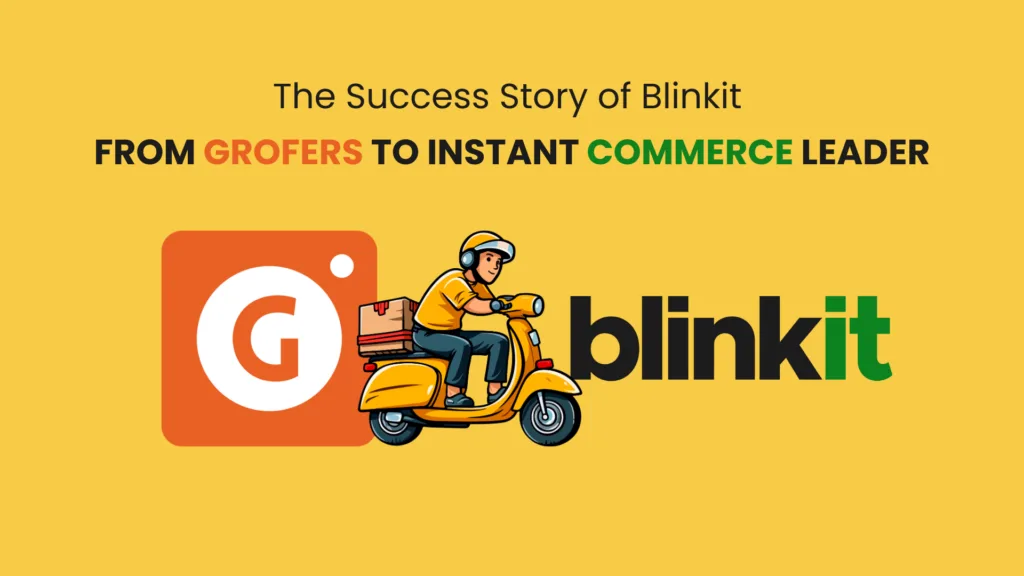
Blinkit, a trailblazer in India’s quick commerce sector, has revolutionized how consumers purchase groceries and daily essentials. What began as Grofers in 2013 has evolved into a major player in ultra-fast deliveries. This detailed account explores Blinkit’s foundation, early challenges, funding milestones, its acquisition by Zomato, and the company’s current standing in the competitive market.
Foundation and Founders


Blinkit was established in December 2013 by Albinder Dhindsa and Saurabh Kumar.
- Albinder Dhindsa: An alumnus of IIT Delhi and Columbia University, Albinder brought expertise in business scaling from his time at Zomato. His strategic insight was pivotal in Blinkit’s development.
- Saurabh Kumar: A graduate of IIT Bombay, Saurabh contributed his operational and technical acumen. Together, they sought to address inefficiencies in India’s grocery retail landscape.
Early Days
Originally branded as Grofers, the company operated on a hyperlocal delivery model, connecting nearby stores with customers to ensure swift delivery of groceries and essentials. Grofers partnered with local vendors and used a user-friendly mobile app. They created a streamlined system allowing customers to browse a wide selection of products. Customers could place orders with ease and receive their deliveries in record time. This innovative approach aimed to address the pain points of traditional grocery shopping, such as long queues and limited availability of items.
The hyperlocal delivery model facilitated convenience for urban dwellers. It also provided local businesses with an avenue to expand their customer base. This fostered mutual growth. In its initial phase, Grofers faced hurdles like logistical challenges, inconsistent inventory, and consumer skepticism about the reliability of online grocery services. However, through relentless efforts in refining its processes and investing in technological advancements, the company gradually gained the trust of its customers and established a solid foothold in the competitive e-grocery market.
Key Aspects of the Initial Model:
- Hyperlocal Collaboration: Partnered with local shops to provide customers with a wide range of products.
- Technology Integration: Developed mobile apps to streamline order placement and tracking.
- Convenience-Oriented Service: Focused on solving urban consumers’ need for efficient grocery access.
Growth and Evolution
From Hyperlocal to Nationwide Reach
As consumer trust increased, Grofers expanded its footprint, transitioning from a logistics provider to a full-fledged e-grocery platform. It began offering a diverse inventory ranging from staples to fresh produce and personal care items.
Rebranding to Blinkit
In 2021, the company rebranded itself as Blinkit, signaling its entry into the ultra-fast delivery space. The name reflects the speed and efficiency of its 10-minute delivery promise.
Strategic Shifts Under Blinkit:
- Advanced Algorithms: Optimized delivery routes and inventory management to enhance operational efficiency.
- Micro-Fulfillment Centers: Established small warehouses within 2 kilometers of high-demand areas to expedite deliveries.
- Customer-Centric Approach: Offered real-time tracking, tailored recommendations, and dynamic offers to improve user experience.
Funding Milestones
Over its journey, Blinkit secured significant investments, enabling rapid scaling and technological advancements.
| Funding Round | Year | Amount Raised | Key Investors |
|---|---|---|---|
| Seed Funding | 2014 | $0.5 Million | Sequoia Capital India |
| Series A | 2015 | $10 Million | Tiger Global, SoftBank |
| Series D | 2018 | $61 Million | SoftBank Vision Fund |
| Pre-Acquisition | 2021 | $120 Million | Zomato, Sequoia Capital |
Impact of Investments:
- Expanded operations to 25+ cities across India.
- Enhanced technological infrastructure.
- Strengthened its competitive position in the burgeoning e-grocery sector.
Acquisition by Zomato
In June 2022, Zomato acquired Blinkit in an all-stock deal worth $568 million. This acquisition marked Zomato’s entry into the quick commerce space, enhancing its service portfolio beyond food delivery.
Strategic Benefits of the Merger:
- Integrated Logistics: Combined Zomato’s extensive delivery network with Blinkit’s quick commerce model.
- Cross-Selling Opportunities: Created loyalty programs and bundled offers across platforms.
- Market Diversification: Enabled Zomato to serve both food and grocery needs, appealing to a broader customer base.
Current Scenario
As of today, Blinkit operates in over 30+ Indian cities, maintaining a stronghold in the quick commerce industry.
Operational Highlights:
- Delivery Commitment: 10-minute delivery backed by micro-warehouses.
- Product Range: 3,000+ SKUs, including groceries, household items, and personal care products.
- Technological Excellence: Uses AI to predict demand, streamline inventory, and optimize logistics.
Market Position:
Blinkit serves over 10 million monthly active users, retaining a significant portion through its efficient service and innovative loyalty programs.
Competitive Landscape:
| Competitor | Unique Selling Proposition (USP) |
|---|---|
| BigBasket | Comprehensive inventory, nationwide reach |
| Zepto | Hyperlocal deliveries in under 10 minutes |
| Dunzo | Multi-purpose, on-demand delivery |
Challenges and Future Prospects
Challenges:
- Profitability Issues: The high costs of logistics in the quick commerce model pose a profitability challenge.
- Intensifying Competition: New entrants in the space increase the need for differentiation. Even Reliance JIO & Amazon India is planning to get into the Quick Commerce Sector.
- Supply Chain Efficiency: Maintaining consistent product quality and availability remains critical.
Blinkit’s transformation from Grofers to a quick commerce leader epitomizes resilience and strategic foresight. By staying attuned to consumer needs and embracing technological innovations, Blinkit has redefined convenience for millions of Indians. As it continues to thrive under Zomato’s umbrella, the company is well-positioned to set new benchmarks in the instant commerce space.
Future Directions:
- Geographic Expansion: Plans to penetrate Tier 2 and Tier 3 cities, broadening its customer base.
- Service Diversification: Exploring new verticals such as pharmaceuticals and electronics.
- Sustainability Initiatives: Focusing on eco-friendly packaging and reducing its carbon footprint.
As of January 02, 2025, Albinder, Blinkit Founder, announced 10 minute Ambulance Service to be available on the App.
Real-Time Innovation: Blinkit Ambulance Service Launch


In a recent announcement on X (formerly Twitter), Blinkit’s CEO Albinder Dhindsa shared an inspiring update about the company’s new initiative: a quick and reliable ambulance service. This bold step aligns with Blinkit’s vision of leveraging logistics and technology for public welfare.
Highlights of the Service:
- Essential Equipment: Ambulances are equipped with oxygen cylinders, AEDs, stretchers, monitors, and emergency medicines.
- Qualified Staff: Each ambulance is operated by a paramedic. It also includes an assistant and a trained driver. This ensures timely and high-quality service.
- Affordable Pricing: Operated at cost-effective rates to prioritize accessibility over profitability.
- Scaling Plans: Starting with five ambulances in Gurugram, Blinkit aims to expand this service to major cities within two years.
This initiative reinforces Blinkit’s commitment to solving real-world problems with innovative solutions. As Albinder aptly put it, “Let’s do our bit and make way for an ambulance always. You never know when you may save a life.”




